PicPort®-Mono, PicPort®-Stereo for both analog and digital inputs and in a variety of PCI formats make up a comprehensive range of OEM monochrome framegrabbers. Video Image formats supported include analog CCIR, RS170 or nonstandard (incl. high resolution, high speed or dual-channel), as well as digital RS-422 or RS-644. The boards offer various real-time image conditioning functions, different synchronization modes, asynchronous acquisition, simultaneous capture, and more. The conditioned image is sent by fast DMA transfer directly to VGA and/or main memory.
PicPort®-Mono and PicPort®-Stereo monochrome framegrabbers are designed for:
- analog and digital cameras
- simultaneous grab
- real-time conditioning
- PCI, CompactPCI, PMC module
¡@
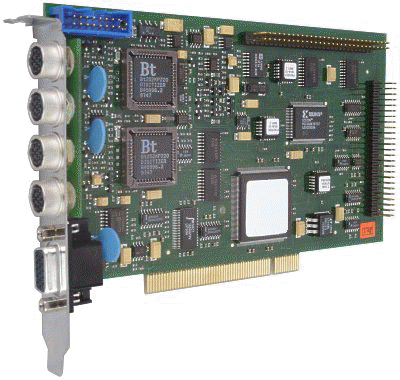
All the PicPort® models are based on similar architecture
.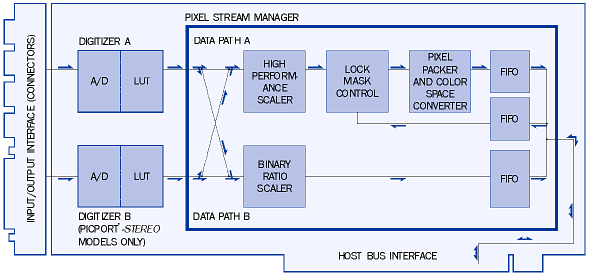
The PicPort® I/O interface generally comprises video input connectors, synchronization and opto-isolated trigger inputs and outputs. The exact physical hardware interface is model-specific.
The analog PicPort®-Mono cards feature one, PicPort®-Stereo models two digitizer channels, each of them handling up to 4 video inputs. Besides the A/D converter, each digitizer channel contains additional circuits for image conditioning.
The Pixel Stream Manager is the real heart of every PicPort®. It consists of two data paths (DMA channels) with different features (see the figure). Data path A features the following circuits: High Performance Scaler for fine interpolating, detail-preserving, image scaling down to approx. 40 ¡Ñ 40 pixels with horizontal plus vertical mirroring, Lock Mask Control for text or graphics overlay on the top of the live image and Pixel Packer and Color Space Converter to perform conversion to a desired color format.
The second data path B contains only the Binary Ratio Scaler. Both data paths contain FIFO buffers for proper synchronizing the DMA transfers.
All boards utilize an on-board controller to guarantee performance of real time critical tasks independent of host processor or operating system.
Each PicPort® board contains a firmware EEPROM that is updated automatically by driver software en-suring compatibility between hardware and software releases. In addition two bytes of the EEPROM are available to OEM’s for use as a Software Dongle.
In general PicPort® boards accept video resolutions up to 2048 ¡Ñ 2048, 2:1 interlaced or non-interlaced mode, pixel shape in accordance with CCIR601 or square.
PicPort® analog models accept video sources compliant with CCIR or RS170 video standards. In addition many non-standard cameras, i.e. progressive scan, can also be interfaced by utilizing an easy to use Camera Editor.
PicPort®-Digital models accept digital video sources with RS-422 or RS-644 interface.
For the analog PicPort® an 8 bit, 20MHz, A-to-D is used to digitize the video input. A programmable Input LUT can be used for real-time manipulation of brightness, contrast, gain and offset.
The digital PicPort® is capable of acquiring 8 bit data at 40MHz or up to 16bit data at 20MHz. An FPGA ensures other pixel formats (i.e. 9 to 15 bits) are also fully supported by means of bit shifting.
Image scaling and mirroring are operations performed by the Pixel Stream Manager with a range of functionality dependent on the data path (DMA channel) used. DMA channel A with its High Performance Scaler uses a mathematical interpolation method independently along both x and y axes, resulting in an image free from any significant loss of detail. Alternatively, when the simpler DMA channel B is used, only vertical mirroring and binary downscaling is available.
By means of a Lock Mask feature, unique to PicPort®, image data flowing through DMA channel A can be overlaid by a 1-bit mask created as a compressed bitmap within Windows in the form of text or graphics.
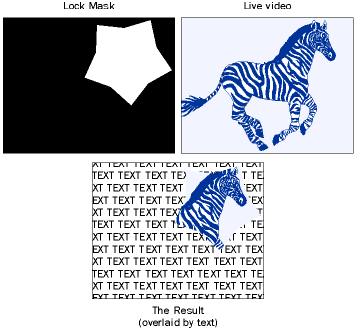
By utilizing the Pixel Packer and Color Space Converter the data on DMA channel A can be converted to monochrome or RGB with predefined color and bit depths.
| Original format | DMA | Target format | Bit use |
| 8-bit, monochrome | A & B | Y8, packed | 8-bit luminance |
| 8-bit, monochrome | A & B | Y2, packed | 2-bit luminance |
| 8-bit, monochrome | A & B | Y1, packed | 1-bit luminance |
| 8-bit, monochrome | A | £\RGB, 32-bit | 8-8-8-8 |
| 8-bit, monochrome | A | RGB, 24-bit packed | 8-8-8 |
| 8-bit, monochrome | A | RGB, 16-bit | 5-6-5 |
| 8-bit, monochrome | A | £\RGB, 15-bit | 1-5-5-5 |
| 8-bit, monochrome | A | RG£\B, 15-bit | 5-5-1-5 |
| 8-bit, monochrome | A | RGB, 8-bit | 3-3-2 |
The digitized and conditioned data is transferred using two independent DMA channels directly to the CPU and/or video memory without on board intermediate storage and with minimal CPU intervention. The board acts as a PCI bus master allowing transfers at peak rates of up to 132 MB/s i.e. real time transfer for all acquisition modes.
The two independent DMA channels provide many modes of operation including:
Simultaneous transfer of video data from a single image source to main memory for processing and to video memory for display.
A dual channel camera, that outputs two fields of the same frame simultaneously, can be combined to build up a complete image in real time. Transfer of images from two synchronized cameras to two independent memory windows.
With PicPort®-Mono and PicPort®-Stereo models the following modes are possible:
In this mode the necessary horizontal and vertical synchronizing information is decoded from the camera’s composite CVBS video signal input. CVBS is the simplest possible synchronization mode.
In addition to the video signal, the PicPort®-Mono/Stereo models accept horizontal synchronizing pulses (line valid) and vertical synchronizing pulses (field/frame valid) from the camera or other external device.
This mode ensures 100% compatibility between the timing of both the camera and board and results in the precise mapping of each pixel to the same storage location every time. This technique results in a high quality noiseless image suitable for measurement applications.
Because the board is matching the rigid geometry of the camera only a single camera may be attached in this mode.
In this mode the PicPort®-Mono/Stereo generates H & V sync signals to control the attached camera(s). When several cameras are synchronized by a single PicPort®-Mono/Stereo a user application can switch between them during vertical retrace (blanking) without any image loss.
In Pixel Synchronized mode the PicPort® generates both H & V sync and pixel clock signals for single or multiple cameras.
The trigger input on the PicPort®-Mono/Stereo can be used with asynchronous reset cameras to initiate a new frame. Similarly output signals from the PicPort® can be used to control strobe lighting etc.
Leutron Vision provides PicPort® boards with a variety of connector configurations to accommodate many special application requirements as briefly described below. Detailed pin-outs and descriptions of all the multi-connectors are available at the chapter Connector description below.
The universal camera connector differs slightly for different PicPort® types, but in general connections are available for 2 video inputs, synchronization + clock I/O and a 12 volt camera power supply.
For more details see the Technical Specification Table.
Opto-isolated connections are available as input or output signals to control board or camera timing.
Has standard female BNC connectors for up to 4 video sources through a single digitizer (not simultaneously).
¡@
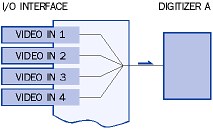
Similar to the PicPort®-Mono except that the 4 video inputs are female Hirose sockets (compatible with many popular cameras). The Hirose 12-pin cable permits the use of synchronizing signals (including pixel clock), so that the board can operate in all sync modes. The cameras can also be powered from the board ?up to 12 V/ 225 mA per camera.
PicPort®-Stereo cards are identical to the PicPort®-Mono models but with a second digitizer channel allowing two different video signals to be captured simultaneously.
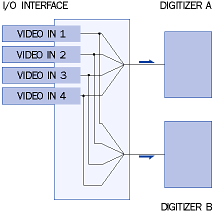
PicPort®-Stereo-H4S are identical to the PicPort®-Mono-H4S models but with a second digitizer channel allowing two different video signals to be captured simultaneously.
Similar to PicPort®-Stereo-H4S but designed for connecting inter-synchronized dual channel cameras (e.g. LV-7500/8500CE). Although up to four cameras may be connected only one is captured at any one time.
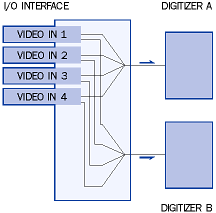
Similar in principle to the PicPort®-Mono-H4 but with eight female Hirose connectors, four connected to each digitizer.
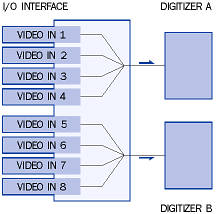
The universal camera connector (100-pin flat connector) can be used for either 1 ¡Ñ 8bit digital input at 40 MHz or 1 ¡Ñ 16bit digital input at 20 MHz. In addition to handling camera timing this connector also has 8 general bi-directional (I/O) signals. All of the signals are transmitted differentially. Physical connection to many popular digital cameras is made simple by the use of an interchangeable front-end daughter board to directly match the pin-outs of the camera being used.
Similar to the PicPort®-Mono-Digital except that 2 inputs are available at 8-bit/40MHz or 2 inputs at 16-bit/20MHz, with simultaneous acquisition of both inputs. All other specifications are as for PicPort®-Mono-Digital.
Based on the PCI bus Revision 2.1 specification PicPort® framegrabbers are available to suit a variety of different hos buses
All Models described above are available for the standard PCI bus.
All analog models are available for CompactPCI bus meeting the demands in severe industrial environments.
In addition this industrial version also offers 8 opto-isolated digital inputs and outputs. Digital models are not available in CompactPCI format until further notice.
The PMC modules provide solutions for applications requiring a flexible embedded design. As standard the PMC modules have a single general-purpose 44 pin HD-sub connector however connector adapters (PMC-CON-XX) matching most popular cameras are also available. The PicPort® PMC models also have 8 opto-isolated digital inputs and outputs. The PMC modules are available in three configurations:
PicPort®-Mono-44S-PMC
Compatible with other analog PicPort®-Mono models: 4 video inputs, 1 digitizer channel.
PicPort®-Stereo-44S-PMC
With 4 video inputs and 2 digitizer channels. Signals from 2 single-channel analog cameras may be digitized simultaneously.
PicPort®-Stereo-44D-PMC
Similar to PicPort®-Stereo-H44S-PMC but designed for connecting inter-synchronized dual channel cameras. Although up to four cameras may be connected only one is captured at any one time. In addition the 4 dual-channel inputs may be also used as 8 single-channel inputs with 2 inputs digitized simultaneously.
Leutron Vision Software Development Suite, LV-SDS, is a software development package (Windows, Linux) that allows full control of all PicPort® products. The suite consists of Daisy - the basic software interface for PicPort® cards, Camera Editor - easy interactive setup of standard and non-standard cameras, DRAWL - a library for handling specific time-critical tasks, Direct Capture - higher level library for the simple design of live-video Windows applications, TWAIN Driver and Video for Windows - provide a simple interface between Leutron Vision hardware and other office and image manipulation programs (e.g. MS Office, CorelDRAW, etc.). Further multimedia drivers, like MCI, are available on request.
Language and hardware independent library containing several groups of powerful image processing functions. It is a robust tool for programming vision and measurement applications in industry, research and scientific areas.
Several well-known third party packages for real-time image processing and analysis are also supported. Please refer to our detailed software brochure for more details.
The software products come complete with a set of demo programs and additional examples with source code as a guide to the programmer in developing particular applications.
Different versions of PicPort®-Mono and PicPort®-Stereo boards are provided with different connector interfaces (as described in Input/Output Connector Configuration). The pin wiring schemes of all the connectors are described below.
Note: You can identify the version number of your PicPort®-Stereo from label sticked on the back side of the board.
15-pin (HD-sub) version for standard PCI bus boards:
| Pin | Signal |
| 5 | Video 0
Input, Signal; shared with BNC0 or Hirose0 1) |
| 10 | Video 1
Input, Signal; shared with BNC0 or Hirose0 1) |
| 15 | Video 0 & 1, Ground |
| 9 | C/HSync Input, TTL |
| 13 | Vsync Input, TTL |
| 3 | Cblank Input, TTL |
| 2 | PClk Input, TTL |
| 12 | C/HSync Output, TTL |
| 7 | Vsync Output, TTL |
| 11 | Cblank Output, TTL |
| 1 | PClk Output (pos), RS422 |
| 6 | PClk Output (neg), RS422 |
| 14 | reserved 2) |
| 4 | +12 VDC/700 mA,
protected (9601.1) 950 mA (9601.2 and higher) |
| 8 | Ground |
| case | Ground |
| 1) Shared means that the same signal is available on both connectors Only one connector can be used at the time. | |
| 2)Customers who are menufacturing their own camera cable must short pin 14 to pin 8 (Ground) inside the DSub male connector | |
12-pin (Hirose) version for CompactPCI bus boards:
| Pin | Signal |
| 3 | Video 0
input, Signal; shared with BNC0 or Hirose0 1) |
| 4 | Video 1
input, Signal; shared with BNC1 or Hirose1 1) |
| 5 | C/HSync input, TTL |
| 12 | VSync input, TTL |
| 10 | PClk input, TTL |
| 6 | C/HSync output, TTL |
| 7 | VSync output, TTL |
| 9 | PClk output (pos), RS422 |
| 8 | PClk output (neg), RS422 |
| 11 | reserved 2) |
| 2 | +12 VDC/950 mA, protected |
| 1 | Ground |
| case | Ground |
| 1) Shared means that the same signal is available on both connectors Only one connector can be used at the time. | |
| 2)Customers who are menufacturing their own camera cable must short pin 14 to pin 8 (Ground) inside the DSub male connector | |
| Pin 1) | Pin 2) | Signal |
| 3 | 2 | Optocoupler Input A0 + 5 V Anode |
| 5 | 3 | Optocoupler Input A1 + 24 V Anode |
| 7 | 4 | Optocoupler Input K Cathode (signal ground) |
| 6 | 11 | Optocoupler Output Emitter |
| 4 | 10 | Optocoupler Output Collector |
| 1 | 1 | TAP 5 V, External Power Supply |
| 2 | 9 | TAP 24 V, External Power Supply |
| 10 | 13 | +5 V power (for test purpose only) |
| 15 | 8 | +12 V power (for test purpose only) |
| 12 | 14 | Common Ground (+5/12 V) |
| 8 | 12 | reserved, do not connect |
| 9 | 5 | reserved, do not connect |
| 11 | 6 | reserved, do not connect |
| 13 | 7 | reserved, do not connect |
| 14 | 15 | reserved, do not connect |
| 16 | NC | reserved, do not connect |
| 1) Pin numbers for the 16-pin flatcable connector CO703 on PicPort-Mono/Stereo On the solder side of the board you can see, that one of 16 pins has square shape, the rest has circle shapes. the one with square shape is pin 1 | ||
| 2)Pin numbers for the optional female Dsub-15 connector on a PC-slot-bracket | ||
Version for PicPort®-Mono-H4, PicPort®-Stereo-H4S and PicPort®-Stereo-H8 models:
| Pin | I/O 1) | Signal |
| 1 | - | Ground |
| 2 | O | +12 VDC |
| 3 | - | Video in, channel 1; Ground |
| 4 | I | Video in, channel 1; Signal |
| 5 | - | Hsync, Ground |
| 6 | O | Hsync, Signal |
| 7 | O | Vsync, Signal |
| 8 | - | Pixel clock in/out, Ground |
| 9 | O | Pixel clock in/out, Signal |
| 10 | - | Ground |
| 11 | O | +12 VDC |
| 12 | - | Vsync, Ground |
| 1) I means Input to PicPort O stands for Output from PicPort | ||
Version for PicPort®-Stereo-H4D models:
| Pin | I/O 1) | Signal |
| 1 | - | Ground |
| 2 | O | +12 VDC |
| 3 | - | Video in, channel 1; Ground |
| 4 | I | Video in, channel 1; Signal |
| 5 | - | Hsync or Csync, Ground |
| 6 | O | Hsync or Csync, Signal |
| 7 | O | Vsync or Pixel clock out, Signal |
| 8 | - | Video in, channel 2; Ground |
| 9 | O | Video in, channel 2; Signal |
| 10 | - | Ground |
| 11 | O | +12 VDC |
| 12 | - | Vsync or Pixel clock out, Ground |
| 1) I means Input to PicPort O stands for Output from PicPort | ||
| Analog models | Digital models | |
| Bus | PCI, CompactPCI, PMC; Revision 2.1 | PCI; Revision 2.1 |
| Video inputs | up to 8, see below | up to 4, see below |
| Input format | CCIR, RS170, nonstandard | RS422, RS644 |
| Video geometry | 2:1 interlaced,
noninterlaced, progressive, dual channel; resolution programmable up to 2048 ¡Ñ 2048 |
2:1 interlaced,
noninterlaced, progressive, dual channel; resolution programmable up to 2048 ¡Ñ 2048 |
| Pixel geometry | CCIR601, square, programmable | CCIR601, square, programmable |
| Digitizers (input channels) |
PicPort®-Mono
models: 1 PicPort®-Stereo models: 2 |
PicPort®-Mono
models: 1 PicPort®-Stereo models: 2 |
| Data digitization | 20MHz, 16-bit per channel | 20MHz/16-bit or 40MHz/8-bit per channel |
| Image coding | 8-bit luminance | up to 16-bit luminance |
| Input LUT | 256 ¡Ñ 8-bit per channel, independently programmable | n/a |
| Brightness | by means of input LUT(s) | n/a |
| Contrast | by means of input LUT(s) | n/a |
| Color hue | n/a | n/a |
| Color saturation | n/a | n/a |
| Gain | programmable (by setting lower and uper conversion threshold) | n/a |
| Offset | programmable (by setting lower and uper conversion threshold) | n/a |
| Downscaling | horizontal 5-tap and vertical 1-tap independently interpolating scaler | horizontal 5-tap and vertical 1-tap independently interpolating scaler |
| Mirroring | along x and/or yaxes | along x and/or yaxes |
| Overlay | freely programmable 1-bit lockmask stored in host memory | freely programmable 1-bit lockmask stored in host memory |
| Color conversion | monochrome or RGB target models with various color depths and data packing | monochrome or RGB target models with various color depths and data packing |
| 8-bit VGA colors display | 20 Windows system colors preserved by means of LUT | 20 Windows system colors preserved with mask |
| Transfer to host | bus master burst DMA transfer | bus master burst DMA transfer |
| Transfer rate | peak rate up to 132 MB/s, real time for all acquisition modes | peak rate up to 132 MB/s, real time for all acquisition modes |
| Synchronization, inputs | CVBS, H/V, pixel clock; TTL or 75 ohm | H/V, pixel clock; RS422, RS644 |
| Synchronization, outputs | H/V, pixel clock; RS422 | H/V, pixel clock; RS422, RS644 |
| Asynchronous acquisition | by external HW trigger | by external HW trigger |
| Plugs for video | universal camera
connector:
|
universal camera
connector:
|
| Trigger in/out | opto-isolated | by means of 8 general i/o differential signals |
| Camera power out | 12 V, up to 900 mA, protected | 12 V, up to 900 mA, protected |
| Other i/o | see section Input/Output Connector Configurations | see section Input/Output Connector Configurations |
| Power requirements | PicPort®-Mono
models:
- 5V/800mA, - +12V/90mA, - -12V/20mA - 5V/900mA, - +12V/90mA, - -12V/20mA the power consumption is increased appropriately) |
PicPort®-Mono
models:
- 5V/800mA, - +12V/90mA, - -12V/20mA - 5V/900mA, - +12V/90mA, - -12V/20mA |
| Operating temperature | 0-50 ¢XC | 0-50 ¢XC |
Comprehensive set of software tools consisting of video capture libraries and image processing libraries for Windows NT4/95/98/2000 and for Linux. Please check especially the following ones:
Video capture library of LV-SDS (Software Development Suite). Object oriented library of functions controlling all features of PicPort® boards.
An easy-to-use application enabling user to connect one of many predefined video sources or specify another, even nonstandard one.
llows acquiring image sequences to the CPU memory.
Leutron Vision offers wide range of industrial CCD cameras. The best suited for work with PicPort®-Mono are:
High resolution camera, various shutter modes, restart/reset capability, field/frame integration.
Similar to LV-75/75CE.
High speed partial scanning camera (up to 360 fps), compatible with LV-75.
Megaresolution (1.3M pixels) progressive scanning camera.
Progressive scanning camera with a single-channel output; remote head version is available.
Low cost camera with high resolution and standard electronic shutter.
The best suited cameras for PicPort®-Stereo are:
Full frame shutter camera with dual-channel output and restart/reset capability.
Similar to LV-7500/8500.
Megaresolution (1.3M pixels) progressive scanning camera.
Progressive scanning camera with a single-channel output; remote head version is available.
High resolution camera, various shutter modes, restart/reset capability, field/frame integration.
Similar to LV-75/75CE.
High speed partial scanning camera (up to 360 fps), compatible with LV-75.
All the necessary cables for connecting a camera to the framegrabber are available.
Low cost framegrabber providing studio quality digitization and preprocessing of color video image.
PentiCam® is an ultra compact, mobile image processing system for industrial and machine vision, based on standard PC technology and Leutron's PicPort® framegrabbers. PentiCam® is available in a variety of different configurations.